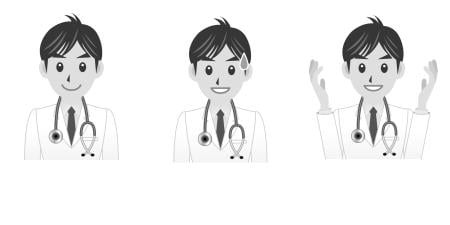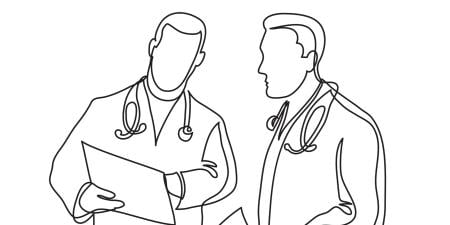Case
Neil is a fourth-year student completing his surgery subinternship at a private teaching hospital. He has been on the service nearly a month and follows 6 patients, visiting and examining them in the mornings and writing their daily progress notes. One of his patients this week is a retired lab technician named Alan, who had a bowel resection for colon cancer 2 years earlier performed by one of the attending surgeons on Neil's surgery team. Alan's lymph nodes had been negative at the time of surgery, and he was told that he was essentially "cured" of the colon cancer. He has felt well since recovering from surgery, except for some shortness of breath over the last month or so. Two days ago, Alan developed a fever and worsening shortness of breath, so he came to the emergency room and was admitted for what looked like pneumonia on a chest x-ray. Alan was pleasant and chatty with Neil during Neil's visits to his hospital room and often expressed his desire to "get over this cold and get back out on the golf course."
One morning, as Neil was writing his notes and looking up lab results, he read that Alan's chest CT showed multiple soft tissue masses in the right and left lung consistent with metastatic colon cancer. Neil's heart sank as he reviewed the CT report, knowing that the prognosis was going to be grim for Alan.
After finishing with his responsibilities on the floor, Neil generally joined the surgeons and residents in the operating room downstairs and discussed any abnormal lab findings or new pathology or radiology reports. As Neil approached the elevator, Alan stepped out of his room and said, "Um, excuse me Doc, I just spoke to a buddy of mine down in radiology, and he said that the reading was in on my chest CT from last night—what's the word on this pneumonia of mine?"
Commentary 2
Medical students often develop special bonds and close relationships with the patients they follow. This can benefit both the educational experience of the students and the care of the patients. In fact, one of the most exciting and important aspects of the clinical years is the development of the communication skills that will make students more effective physicians.1,2
That said, there is no role for the student in discussing new findings or results with their patients. This discussion is one that the patient and his or her physician should have together at the appropriate time and in the appropriate place. The student may have a role to play after this initial discussion has occurred, but under no circumstance should he or she try to intervene prior to that for several reasons.
Neil and Alan seem to have developed a strong relationship. As a medical student, Neil cannot understand all the ramifications of the CT findings and how they might influence treatment plans and prognosis. Is the CT scan 100 percent diagnostic for metastatic cancer, or could it represent a benign disease process? What is the differential diagnosis of these multiple soft tissue nodules? If this is metastatic cancer, what are the treatment options and what is the prognosis? There are many nuances that need to be reviewed, some specific to the disease itself and some specific to the patient. Although it may seem helpful initially to alleviate the patient's anxiety, discussing test results could potentially have damaging repercussions.
Secondly, the hallway is clearly an inappropriate spot to have any conversation about treatment options. The temptation, if a test is negative, is to let the patient know as soon as you see him or her, either by saying "great news on your test" or giving a thumbs-up sign. However, doing this will only bring attention to the reverse situation; that is to say, not giving a sign will imply that the news is bad. It is always a good policy to give news in person and in a safe and comfortable place. Giving news over the telephone, in the hospital lobby, or cafeteria is a bad policy—you won't be able to give proper comfort to a patient in these circumstances if it is needed.
Yet Neil does not want to lie to Alan nor should he. The best way for a student to address this problem is to be honest and state that, as a student, it is not his or her role to discuss any findings with the patient, since he is not the patient's doctor. Neil can say that he will try to find the attending physician and see if he or she has the test results. If it is at all possible, Neil should try to avoid acknowledging that the results are in the computer; the attending physician may be tied up until later that day and unable to get to the patient. This information could cause unnecessary and perhaps unbearable waiting for the patient.
The relationships that students develop with their patients are unique and privileged. A student is often able to sit and talk with a patient for long periods of time, so that he or she can understand the story and chronology of that patient's disease. The patient may look on the student as a friend and ally in an often frightening time and place.3 The student may also communicate some of the patient's questions and anxieties to the attending physician. The student can and should explain some complicated principles about anatomy or basic medical principles (although, again, a student should not discuss treatment options and prognosis with a patient). The third and fourth years of medical school provide medical students with rich and wonderful experiences. Through this process, they learn valuable communication skills that will make them well-rounded physicians.
In summary, medical students should never discuss findings or results with a patient. This must be left to the patient's doctor. This is not to say that the student should never discuss medical issues with a patient; there are appropriate issues to explain to the patient, and a good and healthy relationship should develop between them. In fact, feeling the anxiety that the patient is experiencing will help the student understand patients' feelings better when he or she becomes a doctor.
References
- Yedidia MJ, Gillespie CC, Kachur E, et al. Effect of communications training on medical student performance. JAMA. 2003;290(9):1157-1165.
-
Hopkins MA, Kalet A, Janicek R, et al. Integrating communication skills teaching into the surgery clerkship. Focus. 2003;4:33-35.
- Sieminska MJ, Szymanska M, Mausch K. Development of sensitivity to the needs and suffering of a sick person in students of medicine and dentistry. Medicine, Health Care, and Philosophy. 2002;5(3):263-271.



